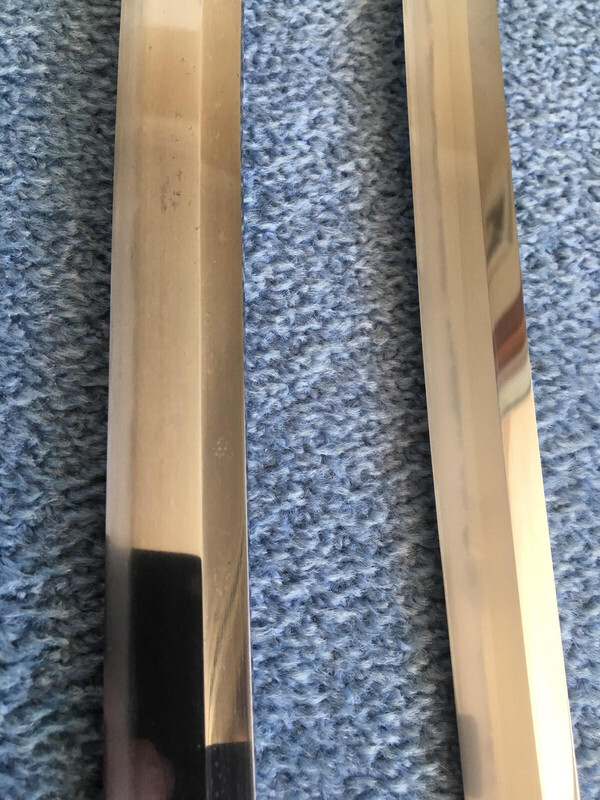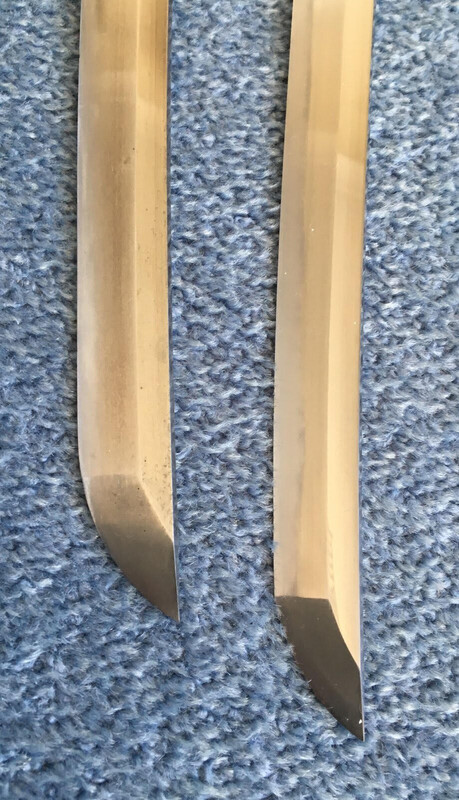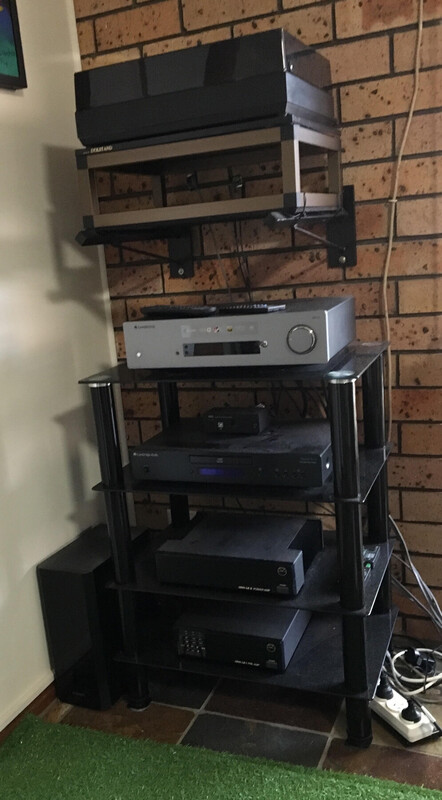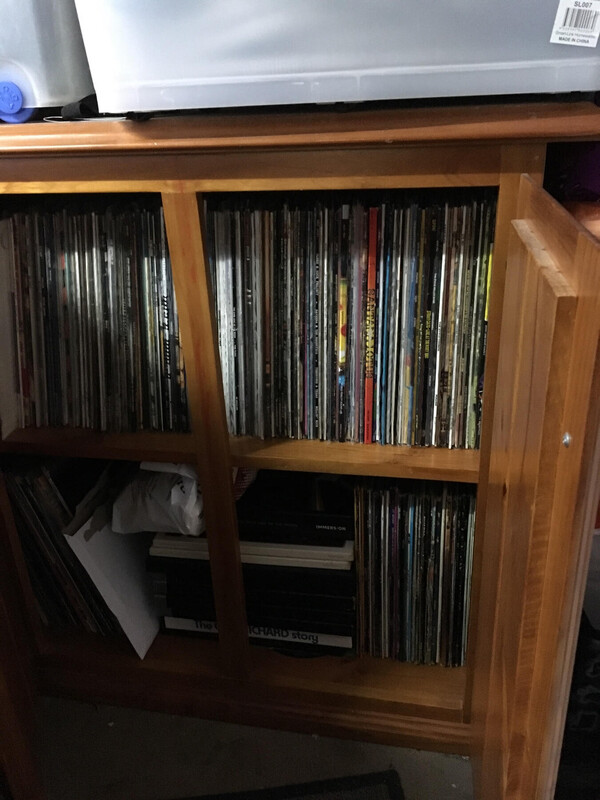-
Posts
1,901 -
Joined
-
Last visited
-
Days Won
85
Content Type
Profiles
Forums
Events
Store
Downloads
Gallery
Everything posted by IJASWORDS
-
George and Brandon both make valid points. Pictured are 2 YASUNORI swords, a Kajiyama and a Kotani, both in war time polish. As they are not rusted, pitted or scratched, a few stains don't really bother me. I have left them in war time polish in original mounts because to me, they are as much a part of military history, as they are Nihonto. Left as they are, the next owner can decide what to do with them, the option is always there. If they were abused, I would agree with Brandon and get them polished. But agreeing with George, I have seen some Keisho polishes that look so un-natural, the swords would have never been intended to be polished that way.
-
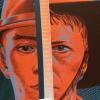
The sword you would never part with?
IJASWORDS replied to PNSSHOGUN's topic in Military Swords of Japan
I had a couple of requests to put up some photos. Some of them have been shown on another thread, but what the heck, I always get a thrill taking it out and having a look anyway. A good "sword buddy" and I went to Japan, and my goal was to find a good polished papered SADAKATSU. And to be honest, the sword found me! Polished, Hozon papers, ayasugi hada, it ticked all my boxes. It took close to 3 months from the time I saw it, until it arrived due to deregistration in Japan, and shipping issues. Many sleepless nights, but worth it in the long run. -

The sword you would never part with?
IJASWORDS replied to PNSSHOGUN's topic in Military Swords of Japan
Good question. Probably my 1933 GASSAN SADAKATSU made and engraved to celebrate the birth of the Crown Prince, later to become Emperor. Has some "catch and kill" meaning for me, as I travelled to Japan to find it! -

newly found Minatogawa Jinja katana
IJASWORDS replied to baldi1942's topic in General Nihonto Related Discussion
Steve, without seeing these on a MINATOGAWA, at your stage of collecting I wouldn't take the risk, unless it has been papered. -
Use this, totally non-abrasive, solvent impregnated wadding. Won't scratch, great for removing surface stains. Recommended to me by a prominent sword collector, and I have recomended it to others. May take a bit of rubbing, but works on stains!
-

Rare Military Mount Sword for Sale—Iida Type
IJASWORDS replied to matthewbrice's topic in For Sale or Trade
Hey Matt, here is the best photo I could take without disassembly. Hope you can see the flat spring steel behind the wood liner. This spring steel is spot welded onto the saya. To be honest, I personally would not attempt a repair. It could be an engineering nightmare, and cause damage. I think the buyer should be satisfied to keep it as is. -
Don't forget Merry Christmas Mr Lawrence. A perfect '98 mounted Gunto.
-

Rare Military Mount Sword for Sale—Iida Type
IJASWORDS replied to matthewbrice's topic in For Sale or Trade
Just a heads up on the spring if anyone is interested. It is a piece of flat spring steel, (NOT a coil spring), that is spot welded to the SAYA and painted over after construction. The picture below shows the location of the spot weld, and how the saya is then painted. Can be repaired after the correct size, location and spring temper is determined. The wood saya liner needs to be removed, the spring spot welded, (very careful not to burn a hole in the saya), and probably re-painted. I can take a better photo of the spring for the lucky buyer if required, but it will be looking through the throat, as I wont disassemble it. -
WOW! Nice sword! Looks like it was made yesterday, it is so good! What provenance did you see relating to the Captain's ownership? Did you photograph that?
-
-
-
That's pretty true Hamfish, thats why I started the high class Gendai thread.
-
KABOKU. George Trotter's comment above in 2015, prompted me to put a few pics up of the sword that he commented won the 2011 Sydney Shinsa. I am "the lucky owner" as George describes. The sword is as interesting as is the historical story above, documenting on the killing of his assassin with a severed hand. This sword is in wonderful polish, and any marks seen in the photos are due to cleaning the oil off.
-
Today, when the latest technology comes out, every one breaks their necks trying to adopt it, ie look at the ques for the latest iPhone, thinking it is better and they must have it. So why wouldn't the same apply in the 1940's when a new technology in steel came out, that some sword smiths rushed to try it, and may even have found the properties better? Even advertising the fact when they cut the mei on the sword?
-
When a sword is made from tamahagne or sponge iron, it is formed into a sword by hammering, folding and forge welding, the iron never melts. The swordsmith controls the carbon content during forging. The forging process removes all the contained gas and slags from the sponge, and the hada you see in a sword is the layers or folds that result from forge welding. So this sponge iron becomes steel (Iron + Carbon). So to answer your question, Sadakatsu made steel from tamahagane or sponge iron ONLY in the traditional forging process, not by a steel separate making process. As I said, the steel in sword making the traditional way has never been melted. For my sins, I am a metallurgist.
- 62 replies
-
- 10
-

-

-

Yamakami Akihisa Late War (Type 3) Gunto
IJASWORDS replied to MacTheWhopper's topic in Military Swords of Japan
Valuations from photos can never be reliable. Estimates can be given based on sale prices of similar swords, in similar condition and in different locations. But then you are basically valuing the sword smith without having a close look at his work. Not saying this sword has any problems, but how do you tell from a photo if a sword has had an a back yard polish and irreparably damaged the geometry. Or other fatal problems. One thing I have learned from collecting, it is about the blade, not the signature. So if a valuation is asked or given, it must be with certain conditions, and a "range" of values to account for the actual properties of the individual sword. So in a case like this, it could be from USD1000 if the bade is stuffed, to USD3500 if the bade geometry if original, shows potential (hada, hamon, hataraki), but at the end of the day, a sword is worth what someone wants to pay. -
Gassan Sadakatsu died in 1943, and there is some debate as to when his son started making his swords, as his father became ill/infirm. These swords still paper paper regardless. Bryce, I don't think the term Western Steel can be attributed to what you have researched. Firstly, it was not made in the "west" and secondly, it was still made from Japanese iron sand. Western steel normally applies to rail tracks made in Europe etc. And as you correctly point out, the steel made in the rotary furnace was still a sponge (like tamahagane) and not a melted refined steel. And metallurgically, if it was not inscribed on the sword, there is NO WAY of determining what metal it was made from. It is interesting you say that the Iron Sand Company was established in 1937. When I was searching the world for my Sadakatsu, a number of collectors said "try and find a pre 1937" , coincidence, I don't know. I found a 1933. I have swords by other smiths that indicate different steels being used in their manufacture, and maybe these new technologies were being shown off as advanced technologies back then, and maybe even superior quality. Regardless, they all paper, and are accepted as true nihonto. And to inscribe the steel companies name on the sword, Sadakatsu must have thought highly of the steel, OR made them for the Steel company as promotional swords of the time.
-
Nice sword, nice photos!
-
You can PM me with a photo, length of saya, width and thickness, I may have a spare somewhere.
-
Jacques, Jacques, Jacques .... The RJT smiths as part of their approval process were issued the scarce tamahagane, and red pine charcoal to ensure their blades conformed to traditionally made Nihonto. The star was added by an inspector, after approval, and raw materials accounted for. Some RJT smiths made swords to special order, that don't have star stamps.
-
Nice pick-up! Nice mounted old blade. Good to find one with a mon as well. Would have originally had a leather combat cover of course. PM me with the Saya length, width and thickness, and I will look through my stuff and see if I can find a suitable leather cover.
-

Horimono Question
IJASWORDS replied to Bruce Pennington's topic in General Nihonto Related Discussion
Bruce, sometimes found on Gunto as a good luck charm or dedication to the Gods for keeping one safe. Here is a WW2 menuki with ken. -

Is this a good time to sell collections?
IJASWORDS replied to Peter Bleed's topic in General Nihonto Related Discussion
Darkon, John, all good questions. An appraisal book just wouldn't work however. For example, I have 2 EMURA'S both signed the same, both in good outfits. Put the 2 together and you could get USD3500 for one, and USD2500 for the other. They are chalk and cheese in regard to workmanship, every sword is different, and appeals to collectors in different ways. In regard to "gendai-to nonsense" as you call it, the WW2 stuff even if "beat up" appeals to both nihonto and militaria collectors. There is a certain "aura" a WW2 gendai-to has, in so much it was made was a weapon, like the Samurai swords of old, and not a piece of art for arts sake. The price is what people are prepared to pay at a particular time. -

Is this a good time to sell collections?
IJASWORDS replied to Peter Bleed's topic in General Nihonto Related Discussion
When I first started collecting (mainly gendai), I would buy at dealer prices. For the past few years, my thought strategy is to pay only what I could recover if I sold it. And if I buy a sword out of polish, I factor in the cost to polish. I have sold quite a few swords on NMB in the past year, and all get snapped up within a day. The reason, realistic prices, I always leave "a bit in it for the next owner". Only an observation, but many shinsakuto swords that have been listed on the NMB, never resell for the price the owner paid, and you see reduction after another, or withdraw from sale. Unless you buy really well, swords are not a good investment, you buy what gives you pleasure, enjoy it, and sell it for the current market price.- 44 replies
-
- 11
-

-




